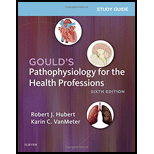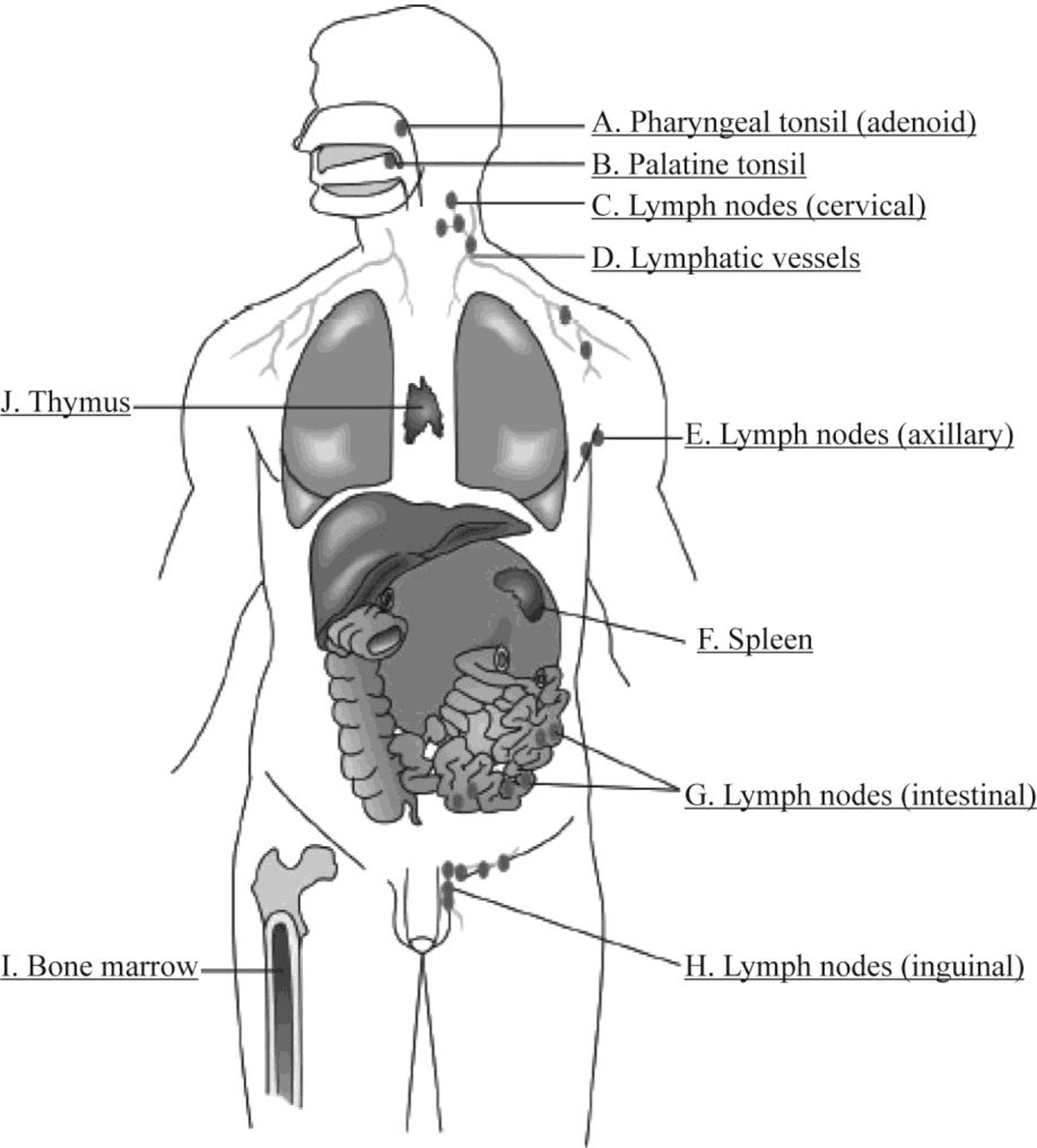
Concept explainers
To state: The three main components of the immune system and match the given terms with the organs.
Introduction: A complex network of cells, tissues, and organs, which works together to protect the body and fight against pathogens or foreign substances are collectively known as the immune system.
Answer to Problem 1P
Pictorial representation: Fig.1 shows the parts of the immune system.

Fig.1: structures involved in immune system
Explanation of Solution
The three main components of the immune system are as follows:
- Lymphoid tissues (lymph nodes, tonsils, spleen, intestinal lymphoid tissue, and lymphatic circulation).
- Immune cells (macrophages and lymphocytes).
- Tissues concerned with immune cell development (bone marrow and thymus gland).
- A. Pharyngeal tonsil (adenoid)
The patch of lymphatic tissues present in the throat that is located behind the nasal cavity, in the roof of the nasopharynx is known as adenoids. It is also known as pharyngeal tonsil or nasopharyngeal tonsil. It functions by trapping the germs that enter through the nose and mouth.
- B. Palatine tonsil
Palatine tonsil is one among the mucosa-associated lymphoid tissues that is located at the entrance of the gastrointestinal tract and respiratory tract. It will protect the body from the exogenous material that enters through the mucosal sites. Palatine tonsils are located on the left and right sides at the back of the throat. They are occasionally called as faucial tonsils.
- C. Lymph nodes (cervical)
The lymph nodes are the secondary lymphoid organs present in the immune system. The lymph nodes are small glands that are situated throughout the body and are linked with the help of lymphatic vessels. These organs are the main sites of B and T lymphocytes. These organs act as a defense system. Cervical nodes are a group of lymph nodes, which are found in the neck region. Out of 800 lymph nodes, the neck region contains 300 lymph nodes. These lymph nodes can lead to various pathological conditions such as infection, tumors, and inflammation.
- D. Lymphatic vessels
The vessels of the lymphatic system reach most parts of the body and collect and return the interstitial body fluids with the blood. It comprises a fluid called lymph that contains waste products and cellular debris collected from the interstitial spaces of tissues. This fluid is taken to the secondary lymphoid organ called as lymph nodes.
- E. Lymph nodes (axillary)
Axillary nodes are located at the armpit (axillary) region of the body. These nodes are responsible for the lymphatic drainage of a large part of the human structure. They mainly perform the filtration and conduction of lymph from the upper back, pectoral region, and upper back.
- F. Spleen
The spleen is the secondary lymphoid organ. It is an organ that is present in the upper left part of the abdomen. It can serve as filters for the blood. The spleen can also help to fight against the bacteria causing meningitis and pneumonia.
- G. Lymph nodes (intestinal)
The intestinal lymph node also called as mesenteric nodes are present in the intestinal region. These types of nodes help to fight against the diseases in our body.
- H. Lymph nodes (inguinal)
Inguinal lymph nodes are the lymph nodes present in the groin (inguinal) region. These nodes are usually located below the inguinal ligament, which runs from the ilium's anterior superior iliac spine to the pubic bone's pubic tubercle. It is mainly classified as superficial lymph node and deep lymph node.
- I. Bone marrow
The spongy tissue called the bone marrow is present in the center of bones. This organ is an important site for the production of blood cells (hematopoiesis). It is the major site where B lymphocytes mature.
- J. Thymus
The thymus is the primary lymphoid organ. It is situated in the neck of vertebrates. Two identical lobes are found in the thymus. They are located in the anterior superior mediastinum, behind the sternum and in front of the heart. The thymus plays a fundamental role in the mechanism of immunity against infections. Before birth, they are the final site for the development of lymphocytes. It secretes hormones after birth, which facilitates the formation of mature T-lymphocytes. These T-lymphocytes help to attack the foreign cells and act as regulators for the immune system.
Want to see more full solutions like this?
Chapter 7 Solutions
Study Guide for Gould's Pathophysiology for the Health Professions
 Phlebotomy EssentialsNursingISBN:9781451194524Author:Ruth McCall, Cathee M. Tankersley MT(ASCP)Publisher:JONES+BARTLETT PUBLISHERS, INC.
Phlebotomy EssentialsNursingISBN:9781451194524Author:Ruth McCall, Cathee M. Tankersley MT(ASCP)Publisher:JONES+BARTLETT PUBLISHERS, INC. Gould's Pathophysiology for the Health Profession...NursingISBN:9780323414425Author:Robert J Hubert BSPublisher:Saunders
Gould's Pathophysiology for the Health Profession...NursingISBN:9780323414425Author:Robert J Hubert BSPublisher:Saunders Fundamentals Of NursingNursingISBN:9781496362179Author:Taylor, Carol (carol R.), LYNN, Pamela (pamela Barbara), Bartlett, Jennifer L.Publisher:Wolters Kluwer,
Fundamentals Of NursingNursingISBN:9781496362179Author:Taylor, Carol (carol R.), LYNN, Pamela (pamela Barbara), Bartlett, Jennifer L.Publisher:Wolters Kluwer, Fundamentals of Nursing, 9eNursingISBN:9780323327404Author:Patricia A. Potter RN MSN PhD FAAN, Anne Griffin Perry RN EdD FAAN, Patricia Stockert RN BSN MS PhD, Amy Hall RN BSN MS PhD CNEPublisher:Elsevier Science
Fundamentals of Nursing, 9eNursingISBN:9780323327404Author:Patricia A. Potter RN MSN PhD FAAN, Anne Griffin Perry RN EdD FAAN, Patricia Stockert RN BSN MS PhD, Amy Hall RN BSN MS PhD CNEPublisher:Elsevier Science Study Guide for Gould's Pathophysiology for the H...NursingISBN:9780323414142Author:Hubert BS, Robert J; VanMeter PhD, Karin C.Publisher:Saunders
Study Guide for Gould's Pathophysiology for the H...NursingISBN:9780323414142Author:Hubert BS, Robert J; VanMeter PhD, Karin C.Publisher:Saunders Issues and Ethics in the Helping Professions (Min...NursingISBN:9781337406291Author:Gerald Corey, Marianne Schneider Corey, Cindy CoreyPublisher:Cengage Learning
Issues and Ethics in the Helping Professions (Min...NursingISBN:9781337406291Author:Gerald Corey, Marianne Schneider Corey, Cindy CoreyPublisher:Cengage Learning





